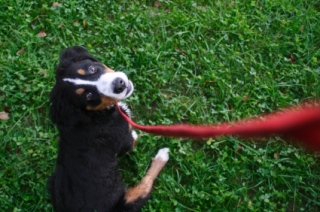Training with Distractions

I made a mistake last week. This isn't really news. As a matter of fact I probably made a mistake every day last week, so I should probably say "I made a mistake last Sunday" or maybe even "I made several mistakes last Sunday night around 11:00PM and I'm thinking of the third or fourth one right now."
Anyway, I was asked to answer an e-mail interview (man I hate that picture) and one of the questions struck me funny. Funny enough that I outsmarted myself. Again, not news — I'm an engineer and experienced in outsmarting myself. (Ask me about the SSL redirector and CPU utilization sometime over beers.)
The question was : What are your views on negative reinforcement? What do you think about dog owners using spray collars and even shock collars?
I immediately jumped to how I have been told several times that shock collars are used more often to administer negative reinforcement than positive punishment. Negative reinforcement as defined by the four quadrants, that is. (The other trainer interviewed on the site was not using that definition.) The problem is (at least in terms of answering the question) is I don't use shock collars and don't plan on it.
I found the question quite puzzling. What are my views on one of the quadrants? When I gave it some thought I found that I don't really use it a lot, but it's not something I dwell on. I don't get up in the morning and say "Gee, I sure hope I don't need to use any R- today." nor do I find myself saying "Technique X would fix this problem, but it's R- and I don't use that."
When it came time for an example I didn't want to put it in terms of two tools I don't use. So, after a few minutes, I thought of standing on the leash in order to get a jumpy dog to stay down during class. It's far from my favorite thing to do, but it was all I could think of late on a Sunday night. Unfortunately my wording could have been better:
There are times where it is in operation - stepping on a leash when a dog is jumping up too much or won't hold a down during a class for example, but it's most associated with much more aversive techniques than I normally use.
Within a couple hours of the interview hitting the twitterverse I received some positive punishment of my own. It was pointed out to me that if a dog is jumping and you step on the leash, it is actually positive punishment.
The picture in my head was a tight leash that loosens when the dog lies down. The picture in the other person's head, due to my referring to a "jumpy dog," was a dog jumping up and hitting the end of the leash.
Note to self: get your blogging done before you watch a three hour German epic without subtitles. It will save you embarrassment and consternation later. (On the other hand, mistakes make for great blog fodder — so maybe I'll try a foreign movie in a language I don't understand at all...full editorial calendar FTW!)
But, and this has more to do with the original question than my mistake and someone's reaction to it, what is it with the quadrants?
The four quadrants were defined as a way to analyze how consequences influence behavior. They are not a moral code, nor are they a training manual.
To paraphrase Dr. Dunbar learning theory can be a distraction.




